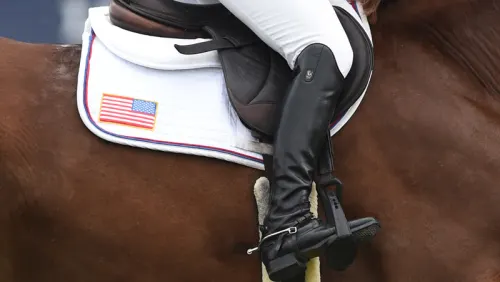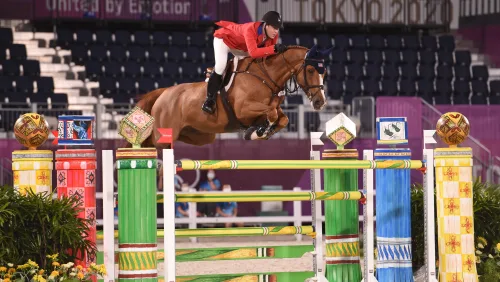Form a team of people who respect each other in the sport of show jumping? Our columnist examines the challenges but concludes it can be done.
We usually consider show jumping to be an individual sport. Whether it’s an amateur rider’s first 3′ class or the Olympic Games, horse and rider cross the start line alone. But no pair reaches their potential without a big team effort behind them.
It takes grooms, veterinarians, farriers and more to prepare the equine partner. It takes years of training and hard work to become truly competitive. Every rider, amateur and professional alike relies greatly on her trainer, coach or ground person. Having a successful career requires a whole team of people and effective teamwork.
Money can buy trainers, veterinarians, farriers, sports psychologists, chiropractors, masseuses, whatever you feel can bring you success. But a team is only as good as it can effectively work together. Effective partnerships need trust and mutual respect.
Trust is key. It usually results when everyone is clearly focused on the common goal. When every member of the team puts the shared goal ahead of all else and can trust that each of the others is doing the same, communication becomes so much easier.
Building trust takes time. Going through rough patches together often cements partnerships and teams. It’s hard to build trust when you don’t all know each other fairly well. A name (or a service) listed on a bill might be good enough for hobby-level activity, but when things get serious it might matter that people know you and the other members of your team when they prioritize their time.
Business Or Sport?
One of the big differences I note between our sport and that of Europe and many other parts of the world involves “business” versus “sport.” In most of the world equestrian activity is really a hobby. People like to compete on weekends, ride a bit during the week, and shows are for pleasure. Small amounts of prize money, lower costs, and locations such as private clubs that pride themselves on good jumps and nice trophies—these are the hallmarks of most of those shows. The really serious riders tend to relocate full- or part-time to where the sport is at a higher standard.
North America and Europe, on the other hand, are based on professional sport, at least at the top levels. Prize money is extraordinary compared with elsewhere, and the conditions demanded are extraordinary as well. To be well regarded, a competition must offer large prize money, be efficiently run, and have only the best of footing and other facilities for competitors, sponsors and fans. It becomes all business on the part of the shows to cover the overhead and a profit.
While there are many similarities today between Europe and North America, one big difference remains: Europe has professional riders, while North America has professional trainers. There are exceptions, of course, yet in Europe most all of the competition takes place in the arena. Only by winning those all-important ranking points to gain entry into the most prestigious tournaments will they be able to win their way to top horses and sponsorships and make a career as a show jumping rider.
North American shows tend to be first and foremost a place of business for management and trainers alike. Professional trainers participate with their clients in nearly every event they want. The road to success for a professional seldom comes from ranking points and wins in the ring but instead from successfully competing for the best clients. Great clients lead to top horses in one’s stable; winning clients lead to longevity and success in the business. The trainer might even get a small string of good horses to ride.
ADVERTISEMENT
Competing Inside The Ring And Outside
Unfortunately, not every great rider is a great teacher or a great salesman. Yet, for all but a rare few (more and more often the children of professionals) there is no direct route to becoming a professional rider in North America, as there is in Europe. It’s dog-eat-dog competition, and often it seems more of the competition takes place outside of the ring than inside it.
When our riders participate in international competition at the top level it can be a difficult challenge to put that competitive business mentality aside and really come together as a team.
Successful teams are greater than the sum of their parts. We saw that in London this summer. The German eventing team, and the British jumping and dressage teams were fine examples.
Every member of each of those teams—not just riders, but grooms, coaches, veterinarians, everyone—shared a single goal. No way was success going to be denied them, despite a generally diverse group making up each team.
When their teams arrived on site, each rider was simply an Olympian from their country, not a professional or amateur, not a youngster or veteran. I believe it’s difficult for our riders to put aside the labels that apply in the business of show jumping or to forget that the day the Games are over it’s back to competition as usual for clients and success at home.
This brings me to the third factor that I believe leads to effective and trusting teamwork: mutual respect. Each member of a well-functioning team deserves the respect of every other member. Ensuring that a horse gets to the ring fit, sound, prepared and happy isn’t a simple task. Only the most dedicated are exceptional at this 24/7/365 job.
Trainers, riders and owners who are part of a team appreciate just how much more there is to the groom’s job, for example, than painting feet and wiping boots before the horse enters the ring. People do their best work in this sport when they love the horses, take pride in a job well done and have the respect of every other member of the team.
Mutual respect is even more essential when it comes to the owner (or parent or sponsor) and the trainer (or coach), yet this is where problems arise. These are essential elements to any team, and the lack of trust and respect for the role each plays tends to distract from the work to be done. Lack of clarity as to each person’s role, together with lack of appreciation for what each brings to the table, really hinders achievement and can often lead to a parting of the ways sooner or later.
It’s hard to know why this business can bring out the worst in some people, but we have to admit that the honest and loyal owner who sticks with a professional who is doing right by him can sometimes seem as rare as the professional who puts the goals and success of his client ahead of personal gain. It isn’t easy for either to find that their trust has been taken advantage of. Going on to forge new relationships based on trust and respect isn’t always easy either.
Owners, and especially parents, should put a great deal of trust in their trainers/coaches. It takes years of experience to learn how to evaluate horses and their suitability for a particular purpose. In selecting horses for a client, a professional must consider the horse, the program it’s been in, and the rider and his own stage of training.
ADVERTISEMENT
The professional knows that forging a good partnership between horse and rider will be an ongoing process and will determine just how successful the client/student will be. No one becomes good at this part of the business without making lots of mistakes along the way.
A professional puts these lessons to good use, but for an amateur going it alone, a series of mistakes can well take the fun out of the sport. Working together with a committed pro isn’t a guarantee to success (no guarantees in this business, I’m afraid), but it’s the surest way to learn and enjoy.
Fellers Sets The Example
We have a wonderful example of how teamwork can pay off with the 2012 Rolex FEI World Cup Finals winners, Flexible and Rich Fellers. Getting to the top from Wilsonville, Ore., was a bigger logistical struggle than for many. If you don’t think so, check MapQuest for the distance from Wilsonville to Wellington!
Rich has put together an incredible team to get a succession of good horses into the winner’s circle over the years. Starting with his wife, Shelley, who is herself a good hand on a jumper (and gets to ride more now that their two children are nearly grown), he has a ground person who knows every nuance of the sport and the horses.
Also key to Rich’s success is the relationship he’s forged over many years with his former sponsor and now client, Harry Chapman, and his wife, Molly. Some might not consider Harry an “easy” owner; he knows too much! Harry rode in his earlier years and continued driving a road horse competitively until fairly recently. He knows the game and has been an active participant in “Team Fellers/Chapman” throughout their years together.
Harry and Molly even drove the horses on many of the long trips to ensure their health and welfare. They, together, have decided on horse purchases, lived through more than a few catastrophic injuries to top horses, arranged the competitive schedules, and made significant changes to their business arrangement—all the while maintaining a string of increasing successes.
With owners like the Chapmans and the wisdom to form strong alliances that could endure the inevitable ups and downs of this sport, Rich worked his way from backyard kid on a little Appy to World Cup Finals winner and Olympian. It’s all about teamwork, trust and mutual respect.
Noted international course designer Linda Allen created the show jumping courses for the 1996 Atlanta Olympics and the 1992 FEI World Cup Finals. She’s a licensed judge, technical delegate and a former international show jumper. She lives in Fillmore, Calif., and San Juan Cosalá, Jalisco, Mexico, and founded the International Jumper Futurity and the Young Jumper Championships. Allen began writing Between Rounds columns in 2001.














